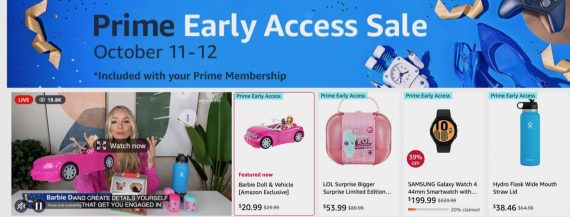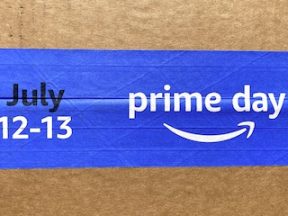For years November’s Black Friday and Cyber Monday sales signaled the kickoff to holiday shopping. Recently, however, merchants have offered discounts before then, diminishing the importance of the two biggest holiday shopping days. This year, Amazon started even earlier with its “Early Access” event for Prime members.
Prime Early Access took place October 11 and 12 — 48 hours — in the U.S., Canada, and 13 European countries. While the event lacked the hoopla surrounding July’s Prime Day, consumers took advantage of the discounts, focusing on household necessities rather than big-ticket items. Amazon said Prime members ordered more than 100 million items from merchants during the sale.

Amazon’s inaugural Prime Early Access occurred October 11-12 in the U.S., Canada, and 13 European countries.
U.S. Results
The following numbers are from market research firm Numerator, which conducted over 3,500 buyer surveys during the Early Access sale.
The average order size during the event was $46.68, down from $60.29 on Prime Day in July. Fifty-six percent of households placed more than two orders, resulting in an average household expenditure of roughly $110.
The top categories consumers said they purchased were household essentials, health and beauty items, clothing and shoes, and toys and games. Twenty-three percent bought everyday items. Only twenty-nine percent of shoppers surveyed said they purchased holiday gifts. American merchants that sold televisions, desktop computers, and other high-end items had disappointing sales.
The top five items purchased during the Prime Early Access sale were:
- Amazon gift cards,
- Amazon photos projects,
- Melissa & Doug toys,
- Simple Joys pajamas by Carter’s,
- Echo Dot.
Best sellers among the Top 100 deals list were the Macbook Air M1, Peloton Bike, Bose earbuds and headphones, and Shark hair dryers, vacuums, and air purifiers.
Globally the best-selling items were apparel, home goods, toys, and Amazon-branded electronic devices.
Fifteen percent of surveyed shoppers said they purchased items they would only buy on sale. Of those respondents who shopped both the Prime Early Access sale and Prime Day in July, 36% spent more at the Early Access event, while 64% spent the same or less.
Twenty-nine percent said they waited for the sale to purchase a specific item at a discount. Shoppers showed a good deal of price sensitivity. Forty-eight percent of shoppers only considered Amazon for their purchases, while 52% considered other retailers.
Why Another Prime Day?
- Amazon’s sales are in a slump. The first two quarters of 2022 showed declining revenues in Amazon’s Online Stores division. The company’s stock has plummeted 33% this year and will likely experience its worst profit year since 2008. Amazon has closed or canceled 44 warehouses.
- The company is wooing new Prime members. Growth in membership has leveled off despite adding many new features such as a free Grubhub+ membership and exclusive access to Thursday night NFL football. Amazon claimed its highest number of new Prime subscriptions in three hours during the first game this season.
- A Prime Day in October could benefit from the trend of early holiday shopping, but this appears not to have occurred.
- The company may have excess inventory to sell.




